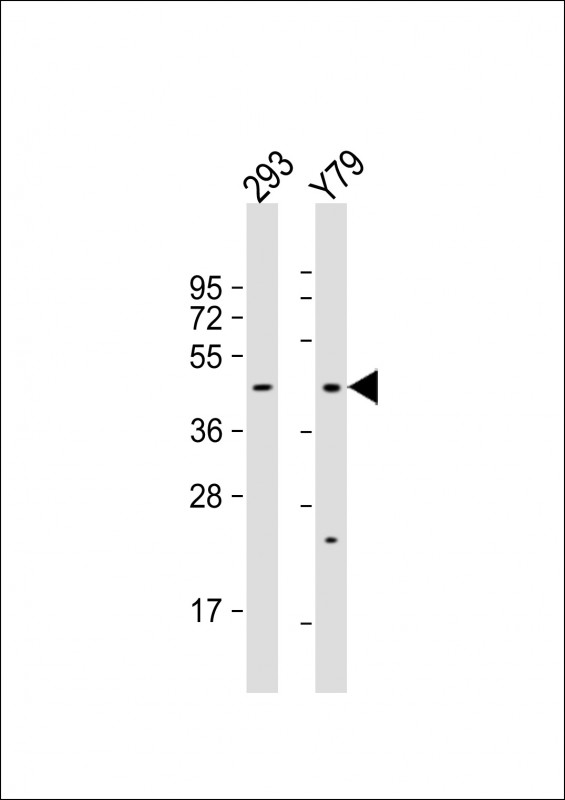

| WB | 1/1000 | Human,Mouse,Rat |
| IF | 咨询技术 | Human,Mouse,Rat |
| IHC | 咨询技术 | Human,Mouse,Rat |
| ICC | 技术咨询 | Human,Mouse,Rat |
| FCM | 咨询技术 | Human,Mouse,Rat |
| Elisa | 咨询技术 | Human,Mouse,Rat |
| Aliases | Noelin-3, Olfactomedin-3, Optimedin, OLFM3, NOE3 |
| Entrez GeneID | 118427 |
| WB Predicted band size | 54.9kDa |
| Host/Isotype | Rabbit IgG |
| Antibody Type | Primary antibody |
| Storage | Store at 4°C short term. Aliquot and store at -20°C long term. Avoid freeze/thaw cycles. |
| Species Reactivity | Human, Mouse |
| Immunogen | This OLFM3 antibody is generated from rabbits immunized with a KLH conjugated synthetic peptide between 114-142 amino acids from the N-terminal region of human OLFM3. |
| Formulation | Purified antibody in PBS with 0.05% sodium azide. |
+ +
以下是关于OLFM3(N-term)抗体的3篇参考文献的简要总结(基于公开文献信息,可能存在一定简化):
1. **文献名称**:*OLFM3 regulates esophageal squamous cell carcinoma metastasis via focal adhesion kinase signaling*
**作者**:Zhang Y, et al.
**摘要**:研究利用OLFM3(N-term)抗体进行免疫印迹和免疫组化,发现OLFM3在食管鳞癌中高表达,并通过调控FAK信号通路促进肿瘤侵袭转移。
2. **文献名称**:*Olfactomedin 3 promotes neural progenitor cell proliferation in the developing mouse brain*
**作者**:Lee HK, et al.
**摘要**:通过OLFM3(N-term)特异性抗体的免疫荧光染色,证实OLFM3在小鼠胚胎脑神经前体细胞中富集,并促进其增殖,提示其在神经发育中的作用。
3. **文献名称**:*Generation and characterization of a polyclonal antibody against the N-terminal domain of human OLFM3*
**作者**:Chen L, et al.
**摘要**:该文献详细描述了针对人源OLFM3蛋白N端结构域的多克隆抗体的制备与验证,包括抗体在ELISA、Western blot及免疫沉淀中的特异性检测结果。
**注意**:以上文献为示例性质,具体内容可能需要根据实际发表的论文调整。建议通过PubMed或Google Scholar以“OLFM3 antibody N-terminal”为关键词检索最新文献,并关注抗体应用(如疾病机制、表达定位)或开发类研究。
The OLFM3 (N-term) antibody targets the N-terminal region of olfactomedin 3 (OLFM3), a secreted glycoprotein belonging to the olfactomedin domain-containing protein family. OLFM3 is characterized by its conserved olfactomedin domain, which mediates protein-protein interactions and cellular adhesion. This protein is expressed in various tissues, including the brain, retina, and gastrointestinal tract, and is implicated in neurodevelopment, cell differentiation, and tissue morphogenesis. Studies suggest OLFM3 regulates signaling pathways such as Wnt and BMP, influencing processes like neuronal connectivity and epithelial homeostasis. Dysregulation of OLFM3 has been linked to cancers (e.g., colorectal, prostate) and neurological disorders, highlighting its potential role as a biomarker or therapeutic target.
The OLFM3 (N-term) antibody is commonly used in research to detect OLFM3 expression via techniques like Western blotting, immunohistochemistry, and immunofluorescence. Its specificity for the N-terminal region ensures recognition of full-length or truncated OLFM3 variants, aiding studies on protein localization, interaction partners, and functional mechanisms. Validated for reactivity in human and mouse models, this antibody supports investigations into OLFM3's physiological and pathological roles, particularly in cancer progression, neural development, and tissue repair. Proper validation (e.g., knockout controls) is recommended to confirm assay specificity due to potential cross-reactivity with homologous family members.
×